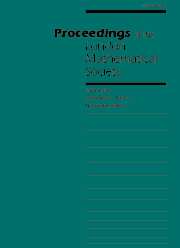Article contents
Exponential Sums and Lattice Points III
Published online by Cambridge University Press: 23 October 2003
Abstract
The Gauss circle problem and the Dirichlet divisor problem are special cases of the problem of counting the points of the integer lattice in a planar domain bounded by a piecewise smooth curve. In the Bombieri–Iwaniec–Mozzochi exponential sums method we must count the number of pairs of arcs of the boundary curve which can be brought into coincidence by an automorphism of the integer lattice. These coincidences are parametrised by integer points close to certain plane curves, the resonance curves.
This paper sets up an iteration step from a strong hypothesis about integer points close to curves to a bound for the discrepancy, the number of integer points minus the area, as in the latest work on single exponential sums. The Bombieri–Iwaniec–Mozzochi method itself gives bounds for the number of integer points close to a curve in part of the required range, and it can in principle be used iteratively. We use a bound obtained by Swinnerton-Dyer's approximation determinant method. In the discrepancy estimate $O(R^K (\log R)^{\Lambda })$ in terms of the maximum radius of curvature $R$, we reduce $K$ from 2/3 (classical) and 46/73 (paper II in this series) to 131/208. The corresponding exponent in the Dirichlet divisor problem becomes $K/2 = 131/416$.
Keywords
- Type
- Research Article
- Information
- Proceedings of the London Mathematical Society , Volume 87 , Issue 3 , November 2003 , pp. 591 - 609
- Copyright
- 2003 London Mathematical Society
- 203
- Cited by


